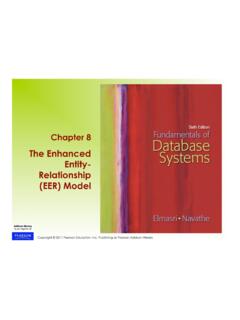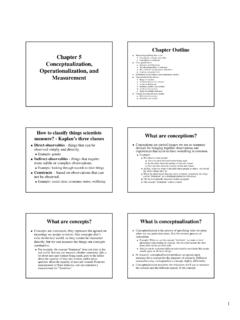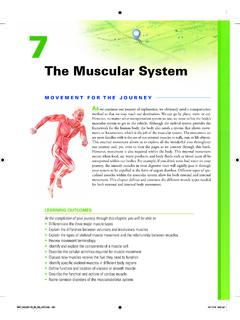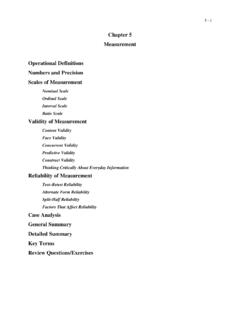Transcription of CHAPTeR 1: Theoretical and Conceptual frameworks for ...
1 CHAPTeR 1: Theoretical and Conceptual frameworks for understanding adolescent problem behavior OVERVIEW change and encompasses both cognitive and behav- ioral approaches. It moves beyond the narrower be- As a platform for this Adjunct Guide to Driving With havioral perspective defined by the early behaviorists Care, we begin by presenting a number of promi- ( , Miller & Dollard, 1941; Skinner, 1938, 1953). nent concepts and theories that provide a concep- and includes the cognitive perspective. Cognitive tual framework for understanding , interpreting and learning assumes that there are psychological factors predicting the development, dynamics, and outcome that influence behavior . of adolescent problems. We look at theories that are particularly relevant to understanding the causal and However, SLT also holds that behavior is influenced dynamic factors of underage AOD use and abuse and by environmental factors, and not just psychological underage impaired driving (UID).
2 An effort is made or cognitive factors. Thus, SLT assumes that psycho- to relate each of these theories to underage drinking logical and environmental factors combined influence and UID. the development of specific behaviors. SUMMARY OF SELECTED Conceptual SLT stresses the importance of attending to and mod- THEORIES eling the behaviors, cognitions ( , attitudes and be- liefs) and emotions of others. SLT sees an interactive Although there are a number of important and cred- process between cognitive, behavioral, and environ- ible Conceptual orientations that can help in under- mental influences (Ward & Gryczynski, 2009). standing the causal and dynamic factors of UID, we select eight that cover the essential psychosocial ele- There are three principles that help define SLT. ments of UID.
3 These are: Observational learning is achieved when the Social Learning Theory (SLT) modeled behavior is structured or organized and then rehearsed symbolically, and then overtly en- problem behavior Theory (PBT) acted. Retention of that behavior occurs when Theory of Planned behavior (TPB) the modeled behavior is coded into words, labels or images. Social Norms Theory (SNT). The adoption of the modeled behavior is strength- Transitional Teens Theory (TTT). ened when the outcomes of that behavior are val- Cognitive-Behavioral Therapy (CBT) ued, seen as important to the individual or lead to Acquired Preparedness Model (APM) desirable and expected outcome. Social and Community Responsibility Theory The modeled behavior is more likely to be in- (SCRT). tegrated by the observer when the model has characteristics similar to the observer, there is a cognitive-behavioral connection with the model, Social Learning Theory (SLT) the model is admired by the observer, and the be- havior that is adopted has practical or functional We consider social learning theory (SLT: Bandura, value.)
4 1969, 1973, 1977a, 1986; Bandura & Walters, 1963). as providing a broad-band explanation for both desir- able and undesirable behavioral outcomes. It includes SLT defines four requirements for learning and mod- a broad array of theory and practice in learning and eling behavior . 6|. Attention to the modeling events in the environ- However, in today's world, that is quite unlikely. Ob- ment and the characteristics of the observer to at- serving and modeling behavior can be very subtle. tend to those events (emotional, perceptual set, Certainly, many circumstances will determine the arousal level). individual's exposure to potential models. The im- portant factor is that once the behavior is adopted, in- Retention, which is the cognitive component ternally coded, and reproduced in such a manner that involving remembering what one observed, cod- it leads to some kind of positive reinforcement, that ing, organizing and rehearsing it at the cognitive behavior will continue to be reproduced.
5 However, level. behavioral outcome may be perceived to be undesir- Reproduction or the ability to reproduce or copy able to the individual, decreasing the probability that the behavior which includes observing the self re- the behavior will continue. producing the behavior and feedback of the ac- curacy of that reproduction. Emerging out of Bandura's SLT is self-efficacy theory Motivation or behavioral consequence that justi- (1982, 1986, 1995, 1997). He saw outcome expec- fies wanting to adopt the behavior which includes tancy as the individual's judgement that a certain self-reinforcement. behavior will lead to a certain and desired outcome. He defined self-efficacy as the belief that one can suc- cessfully engage in a behavior that is required to pro- Rotter's (1954) work on social learning involved the duce a desired outcome.
6 Bandura sees self-efficacy desire to avoid negative consequences, the likelihood as a critical factor in cognitive and behavioral change of engaging in a behavior if the expectation is that since it determines the execution of learned cognitive it will lead to positive outcomes, and the reinforce- and behavioral coping skills. ment of the behavior when it does lead to positive outcomes. Bandura expanded on the social learning problem behavior Theory (PBT). concepts of Rotter and Miller and Dollard (1941). problem behavior theory (PBT: Jessor, 1987, 1991, Social learning theory can be used to explain the devel- 1998; Jessor & Jessor, 1977) is a broad-band and opment of deviant behavior , substance use and abuse widely used theory to explain dysfunction and mal- and impaired driving. Theoretically, if an individual adaptation in adolescence.
7 The fundamental prem- never observed these behaviors, then those behaviors ise of PBT, developed initially from Merton's (1957). would never be learned. If a child or adolescent never concept of anomie and Rotter's (1954) social learning was exposed to substance use, to individuals commit- theory, is that all behavior emerges out of the struc- ting crimes, or to impaired driving, theoretically the ture and interaction of three systems. individual would never adopt the behavior . Once it is adopted, the behavior leads to positive consequences The behavior system includes both problem and or outcomes, , acceptance by the group, sense of conventional behavior structures. problem be- power, attention of peers, establishment of a group havior is defined as behavior that departs from role that instills a sense of pride, etc.
8 The degree of the social and legal norms of society and causes positive reinforcement will determine whether the social control response from external sources. behavior is continued. Group norms become a power Underage drinking, risky and impaired driving, base for this reinforcement. and deviancy are seen as problem behavior . Con- ventional behaviors are those that are socially and SLT has its limitations with respect to explaining cer- normatively expected and accepted. tain behaviors learned under certain conditions. For example, it is conceivable that a child could commit The personality system involves a composite of a crime having never observed someone committing persistent enduring factors and includes the moti- a crime. vational-instigation structure, determined by value placed on achievement and independence; the personal belief structure, related to a person's con- |7.
9 Cept of self relative to society; and personal control support drinking and driving. structure, which gives a person reasons to not par- Some problem behavior is based on age-graded norms ticipate in problem behavior . problem behavior whereas others are not. For example, alcohol use for often results from personality patterns related the underage is considered to be a component of to low achievement, focus on independence, fa- problem behavior , but not for adults. In most states, vorable attitudes towards deviancy, adoption of any use of alcohol before driving constitutes impaired values that are counter to social expectations and driving (based on zero-tolerance laws). Impaired lower self-esteem. driving, regardless of age, is considered to be problem The perceived environment system includes behavior .
10 Two structures: distal, inclusive of a person's re- lationship to their support network, and proxi- A large research project conducted by Klepp and Per- mal, which deals with a person's environment ry (1990), using PBT, found that perceived environ- in relationship to available models of behavior . mental, personality and behavioral factors were able problem behavior in the environment often elic- to account for a large proportion of the observed vari- its high peer approval, peer models, low parental ance in impaired driving as well as in the prediction control, support and influence, and incompat- of the onset of impaired driving. This study identified ibility between parent and peer expectations. the following five factors that were most predictive of DWI conduct and which provide a foundation for developing UID prevention and intervention pro- PBT holds that when the personality system and per- grams: ceived environment system clash, behavioral problems become manifest (Jessor, 1987).


















